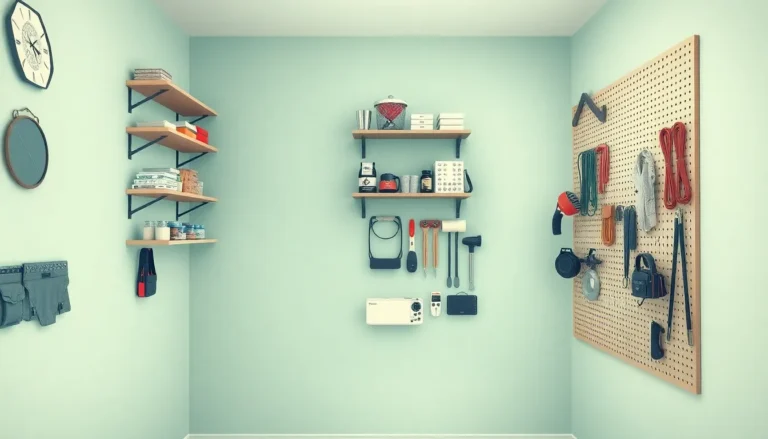Table of Contents
ToggleBuying a home for the first time can feel like trying to solve a Rubik’s Cube blindfolded. The excitement is real, but so are the questions—especially when it comes to down payments. How much do you really need? Is it like finding a unicorn or just a little more than your last vacation fund?
Understanding First-Time Buyer Down Payment Requirements
First-time homebuyers often grapple with down payment requirements. Each program varies in required percentages, typically ranging from 3% to 20%. Nationwide, many lenders offer various loan options to ease this burden. Conventional loans often necessitate a minimum of 3% down, while FHA loans may allow as little as 3.5% for qualified applicants.
Some states and local programs provide down payment assistance. These assistance programs sometimes cover all or part of the down payment. It’s essential to research options available and eligible criteria.
The main challenge lies in understanding the impact of down payment size on mortgage insurance. High down payments often lead to lower monthly mortgage insurance premiums. It’s also important to note that many lenders require private mortgage insurance (PMI) for down payments below 20%.
Credit scores influence down payment requirements significantly. Strong credit scores can lead to lower down payment expectations. Conversely, lower scores may increase the percentage needed upfront.
Ultimately, the total amount needed for a down payment depends on the home price and the loan type. Calculating potential down payments based on estimated home prices can offer clearer insights.
In addition, first-time buyers should factor in closing costs, which typically amount to an additional 2% to 5% of the home’s purchase price. Preparing ahead aids in setting realistic financial expectations for homeownership.
Importance of Down Payments for First-Time Buyers
Down payments play a crucial role for first-time buyers, influencing both financial stability and loan approval. Understanding their significance can guide new homeowners through their purchasing journey.
Financial Security
Down payments contribute significantly to financial security for first-time buyers. Having a substantial down payment lowers the amount borrowed, which reduces monthly mortgage payments. With a smaller loan amount, buyers face less financial strain. Additionally, higher down payments often lead to favorable loan terms, including lower interest rates. This reduction in financial obligation helps create a buffer against future economic fluctuations. Buyers achieve peace of mind knowing they own a larger portion of their home upfront, providing reassurance in their investment.
Loan Approval Process
Down payments directly impact the loan approval process for first-time buyers. A larger down payment demonstrates financial responsibility and stability to lenders, increasing the likelihood of securing a mortgage. Conventional loans often require a minimum down payment of 3%, while options like FHA loans might allow as little as 3.5%. Buyers with higher down payments may qualify for better terms, such as lower interest rates and reduced mortgage insurance costs. Preparing a larger down payment can simplify the approval process and open doors to more favorable lending options for first-time buyers.
Common Down Payment Options
First-time homebuyers encounter various down payment options that impact their financial journey. Knowing these options ensures informed decisions.
Conventional Loans
Conventional loans often require a minimum down payment of 3%. This option appeals to many first-time buyers who may struggle to save larger amounts. Lenders use credit scores to determine specific requirements for these loans. Those with strong credit may secure better rates with lower down payments. Depending on the borrower’s situation, putting down 20% eliminates private mortgage insurance, which reduces monthly payments. This makes budgeting simpler for homeowners. Flexibility in down payment amounts allows for creative financing options, accommodating diverse financial situations.
FHA Loans
FHA loans provide a more accessible path for many first-time buyers, permitting down payments as low as 3.5%. These loans target individuals with limited savings or lower credit scores but stable income. Provisions within FHA guidelines help ease the path to homeownership. Mortgage insurance is obligatory with these loans, affecting monthly payments. While the upfront cost might seem daunting, the requirements are often more lenient than conventional loans. Many buyers discover that, despite the insurance, FHA loans represent a viable and attractive solution for achieving homeownership.
Factors Influencing Down Payment Amounts
Several elements significantly impact the down payment amount for first-time buyers. Understanding these factors helps in planning and budgeting effectively.
Credit Score
Credit scores play a vital role in determining down payment amounts. Higher credit scores often lead to lower down payment requirements. Buyers with scores above 740 usually enjoy more favorable lending conditions. In contrast, those with scores below 620 may face steeper down payment expectations. Lenders assess creditworthiness to evaluate risk, so a strong score can ease the financial burden. Specific mortgage programs or FHA loans also consider credit scores when setting down payment thresholds.
Property Type
Property type impacts down payment amounts as well. Conventional loans often require higher down payments for investment properties than for primary residences. Buyers of multi-unit residences generally need larger down payments compared to single-family homes. FHA loans offer more flexibility, allowing lower down payments on various property types. Additionally, new constructions or co-ops may impose different requirements, emphasizing the importance of property selection when planning finances. Understanding these distinctions ensures informed decision-making in the home-buying process.
Tips for Saving for a Down Payment
Saving for a down payment can feel overwhelming, but with the right strategies, it’s manageable.
Budgeting Strategies
Establishing a budget is crucial for first-time buyers aiming to save effectively. Create a detailed monthly budget that identifies income sources and tracks expenses. Prioritize essential costs while minimizing non-essentials like dining out. Set a specific savings goal to motivate consistent savings. Consider using a high-yield savings account that accrues interest, which accelerates the savings process. Regularly review spending habits to identify additional areas where savings can occur. Utilize tools like automatic transfers to ensure consistent contributions to the savings fund.
Assistance Programs
First-time homebuyers often find financial assistance programs beneficial in alleviating down payment burdens. Identify local and state programs designed to help buyers navigate financial challenges. Some programs offer grants that cover a portion or the entirety of the down payment. Others provide low-interest loans specifically for down payments. Researching options through HUD or local housing agencies can unveil many resources. Many employers also provide assistance options, so checking benefits programs can unlock additional support. Connecting with nonprofits focused on housing can yield valuable insights on further assistance opportunities.
Navigating the down payment requirements as a first-time buyer can be daunting but understanding the available options makes it manageable. By exploring various loan programs and assistance opportunities, buyers can find solutions that align with their financial situations.
It’s vital to consider how down payments impact overall mortgage costs and approval chances. With careful planning and budgeting, first-time buyers can set themselves up for success in their homeownership journey. Ultimately, taking the time to research and prepare can lead to a smoother process and a rewarding experience in finding the perfect home.







